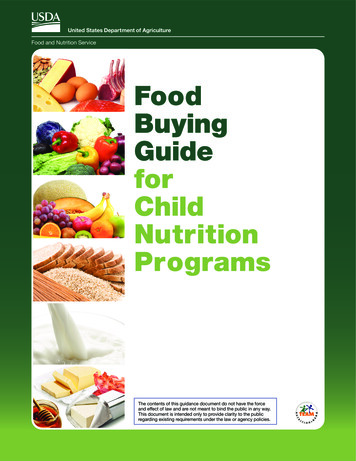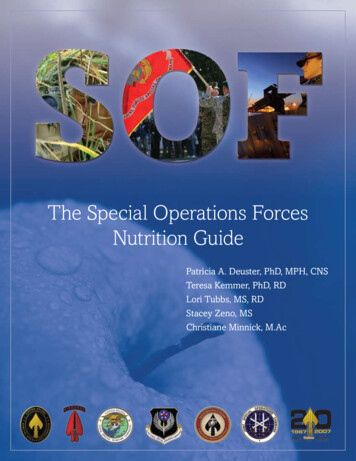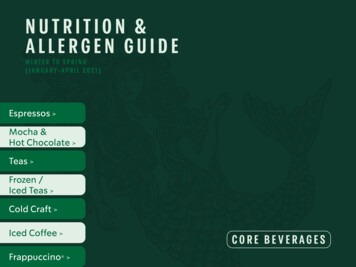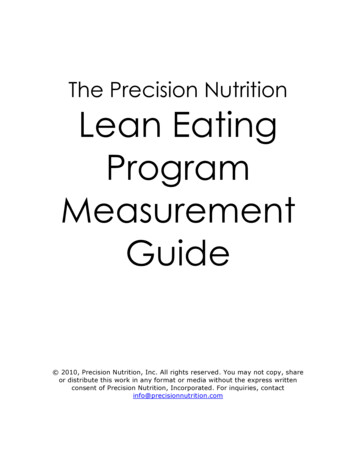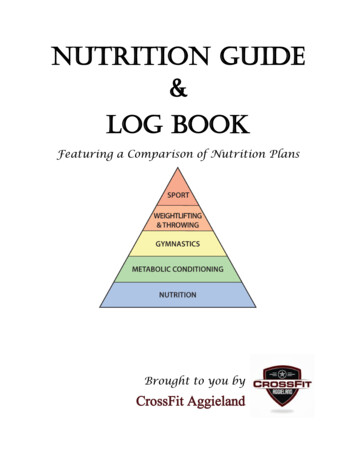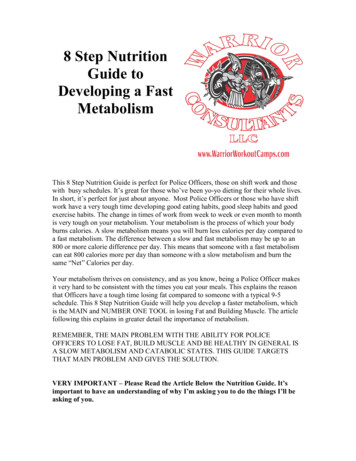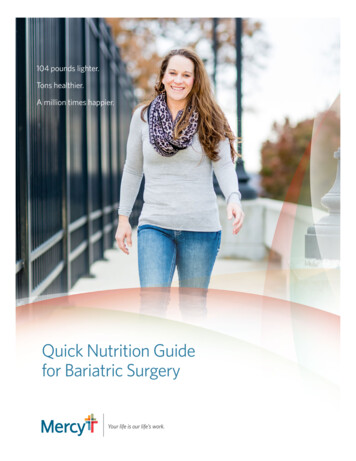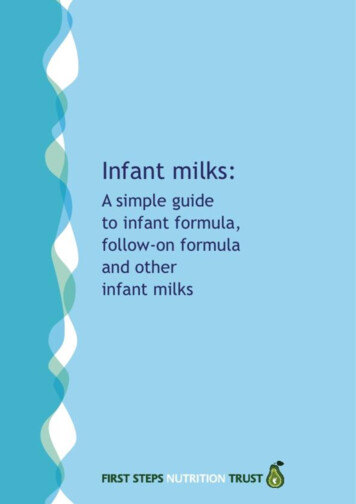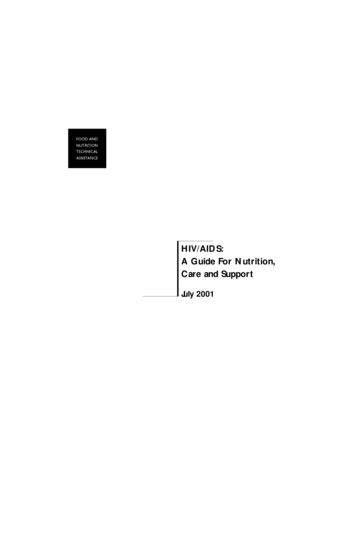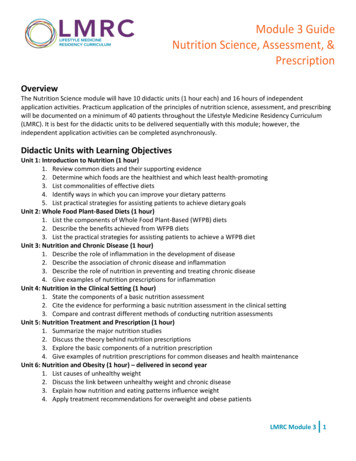
Transcription
Module 3 GuideNutrition Science, Assessment, &PrescriptionOverviewThe Nutrition Science module will have 10 didactic units (1 hour each) and 16 hours of independentapplication activities. Practicum application of the principles of nutrition science, assessment, and prescribingwill be documented on a minimum of 40 patients throughout the Lifestyle Medicine Residency Curriculum(LMRC). It is best for the didactic units to be delivered sequentially with this module; however, theindependent application activities can be completed asynchronously.Didactic Units with Learning ObjectivesUnit 1: Introduction to Nutrition (1 hour)1. Review common diets and their supporting evidence2. Determine which foods are the healthiest and which least health-promoting3. List commonalities of effective diets4. Identify ways in which you can improve your dietary patterns5. List practical strategies for assisting patients to achieve dietary goalsUnit 2: Whole Food Plant-Based Diets (1 hour)1. List the components of Whole Food Plant-Based (WFPB) diets2. Describe the benefits achieved from WFPB diets3. List the practical strategies for assisting patients to achieve a WFPB dietUnit 3: Nutrition and Chronic Disease (1 hour)1. Describe the role of inflammation in the development of disease2. Describe the association of chronic disease and inflammation3. Describe the role of nutrition in preventing and treating chronic disease4. Give examples of nutrition prescriptions for inflammationUnit 4: Nutrition in the Clinical Setting (1 hour)1. State the components of a basic nutrition assessment2. Cite the evidence for performing a basic nutrition assessment in the clinical setting3. Compare and contrast different methods of conducting nutrition assessmentsUnit 5: Nutrition Treatment and Prescription (1 hour)1. Summarize the major nutrition studies2. Discuss the theory behind nutrition prescriptions3. Explore the basic components of a nutrition prescription4. Give examples of nutrition prescriptions for common diseases and health maintenanceUnit 6: Nutrition and Obesity (1 hour) – delivered in second year1. List causes of unhealthy weight2. Discuss the link between unhealthy weight and chronic disease3. Explain how nutrition and eating patterns influence weight4. Apply treatment recommendations for overweight and obese patientsLMRC Module 3 1
Module 3 GuideNutrition Science, Assessment, &PrescriptionUnit 7: Nutrition and Cardiovascular Disease (1 hour) – delivered in second year1. Understand the pathologic processes leading to Cardiovascular disease (CVD)2. Explore the nutritional evidence for the prevention, treatment, and reversal of the followingcardiovascular-related diseases: Hyperlipidemia Hypertension Heart Disease StrokeUnit 8: Preventing and Reversing Diabetes with Nutrition (1 hour) – delivered in second year1. Describe common consequences of intensive medication management for type 2 diabetes (T2DM)2. List the benefits of preventing, treating and reversing T2DM with Lifestyle Medicine3. Summarize key nutrition research on the impact of diet on T2DM4. Describe the major physiological impacts of a plant-based diet in the process of T2DM reversalUnit 9: Epigenetics and Nutrition (1 hour) – delivered in second year1. Discuss key epigenetic mechanisms2. Discuss key epigenetic influencers3. Describe the relationship between lifestyle factors and gene expression4. Describe the role of epigenetics in lifestyle-related diseaseUnit 10: Nutrition and Cancer (1 hour) – delivered in second year1. Review evidence on overall dietary pattern for the primary prevention of cancer2. Give examples of specific food or food groups for the primary prevention of cancer3. Discuss the role of nutrition and time-restricted eating in the treatment and sustained remission oflifestyle-related cancers such as breast, prostate, and colonIndependent Application ActivitiesYou will need to complete a total of 16 hours of these activities. Note that each activity is worth varyingamounts of time. Please choose which activities fit your learning needs and interests.1. Whole food plant-based cooking (Credit 2 hours)You may do this activity 4 times for up to 4 hours – report actual time spent.A. Make a whole food plant-based dish. (Consider trying the provided recipes by Dr. Fay Kazzi.)B. Try making each dish with a fellow resident or family member.C. Identify health benefits of individual ingredients of each recipe.D. Submit a photo of each meal for credit.2. Research popular diets (Credit 1 hour)May be done as a group.A. Select at least 3 diets: Ketogenic diets, Mediterranean, Paleo/Whole 30, etc. Can you identify risks and benefits of each diet you’ve selected?B. Where do the diets differ?LMRC Module 3 2
Module 3 GuideNutrition Science, Assessment, &PrescriptionC. What do these diets have in common with a Whole Food Plant-Based Diet? Using diets that patients are familiar with and finding commonality (instead ofdifferences) can be a positive tool when educating patients on WFPB.D. Submit a response in any media format of your choice: including research paper, video skit,infographics, etc.3. Review two articles on the ACLM website related to nutrition (Credit 1 hour)A. Find articles here: nceB. Consider how each article may relate to your practice and/or change to your practice patterns.C. Prepare 2 learning points from each article and complete the following: Share the 2 learning points with 2 colleagues in professional language. Share the 2 learning points with 2 patients in lay language. Reflect on how this sharing was received and make changes to the messaging asneeded.4. Comparison challenge: plant-based vs. meat-based meals (Credit 1 hour)A. Log on to Walmart.com or other online grocery site to build a shopping list for a plant-basedmeal and a shopping list for a meat-based meal. Example comparison: A simple lentil soup compared to a hamburger helper meal.B. Calculate the costs. Was the cost comparable?C. Calculate and compare the nutrition content. What were the major differences in macro- andmicronutrient content?D. Print shopping cart web page and nutrient analysis for credit. Include one paragraph summary.5. Assess your own macro- and micronutrient intake (Credit 1 hour)A. Complete a 24-hour food recall.B. Calculate your macronutrient balance from the day. What are your Carbohydrate:Fat:Protein ratios? Dr. Campbell and Dr. Esselstynrecommend 80:10:10.C. Edit your original 24-hour recall making it more in line with the ratios recommended above. Although it is recommended the carbohydrate macronutrient level should be high,remember the type of carbohydrate makes a big difference.D. Fiber is considered a carbohydrate. What sources of fiber were included in your original recalland your updated recall? How does the amount of fiber you consumed compare torecommended and ideal values?E. Submit drawn graph of macronutrient results.6. Childhood food experiences (Credit 2 hours, Group Activity. Bring a typical childhood packed lunchto a group event to discuss OR Credit 30 min; Submit reflection 1-page paper if unable to joinLMRC Module 3 3
Module 3 GuideNutrition Science, Assessment, &Prescriptiongroup)A. What did your parents provide for meals? What did they teach you about food? How does thisinformation affect your food choices now as an adult? Write down or discuss your favorite foods, food given as a reward, common mealsyou would consume including holidays/family get togethers. How did your culture and/or geographic location influence food choices?B. Highlight the themes that arise. Were there home cooked meals, frozen dinners, or fast food?C. Was there any emotion involved with the choices? Was food used as a reward or comfort?D. What was a typical school lunch? If you have children, how does their lunch compare?E. What might a WFPB packed lunch look like?7. Research local community supported agriculture (CSA) farms, vegetable box companies, andfarmer’s markets (Credit 1 hour)A. Compare and contrast cost and availability. How much food does one vegetable box provide a family? Is it affordable?B. Where are the CSA and vegetable pick-up locations? Can food be delivered to your home? Ifnot, are there accessible bus stops and transportation to and from the vegetable box pick-uplocations and farmers markets on the list provided?C. Prepare a written or computer version of patient recommendations for affordable vegetables.8. Practice writing nutrition prescriptions (Credit 30 min)You may do this activity 2 times for up to 1 hour. Submit minimum of 4 handwritten prescriptions.A. As physicians, we write prescriptions for medications at almost every patient visit. For this exercise, work together with another resident. Discuss openly with your peeran area in your diet where you feel a nutrient requirement is not being met or havesymptoms worth addressing.B. Write a specific prescription to your peer for a given nutrient. Make sure to include type,amount, frequency. For example, if you want a patient to consume more Vitamin K s/p a gastrointestinalbleed, you could write a script like the following: 1 cup of spinach daily for 3 weeks. What other micronutrients are certain foods rich in that are commonly takensupplements? Create a list of foods instead of supplements: Omega 3s, B12, Iron,Folate, etc.C. After practice with food as prescription for specific nutrients, try writing a prescription for aspecific dietary pattern for your patient. For example, a patient who has inflammation needs to increase their antioxidants.Categories of foods can also be used: like berries and cruciferous vegetables insteadof specific foods like broccoli or blueberries.LMRC Module 3 4
Module 3 GuideNutrition Science, Assessment, &Prescription Create a list general food categories and conditions/symptoms they can address.9. Volunteer at a local food kitchen (Credit 1 hour)A. See the food given to participants. Calculate the percentage of WFPB food items distributed.B. Create meal plans with the food distributed. Could you do it?C. Reflect on your experience.D. Submit photos of typical food distributed and submit 250-word reflection of experience.10. Complete either the nutrition guidelines or the nutrition prescriptions work from the PowerPoint byDr. Wayne Dysinger (Credit 30 min per activity)Complete both for up to 1 hour.A. Submit answers in a Word document for credit.11. Join a WFPB meal kit service (Credit 2 hours)A. Options include: Green Chef, Sunbasket, Purple Carrot or other similar service.B. Note that not all of the meal options for these services are WFPB and some meals may containhigher amounts of oil/salt than optimal.C. Did you adjust any of the meals you made to make them healthier? How would you instruct apatient who is interested in using a WFPB meal kit service?D. Submit photos of your food creation for credit along with your answers to “c” above.12. Watch Forks Over Knives, What the Health, Food Inc., or a similar nutrition-focused documentary(Credit 1 hour)Group Activity.A. Submit group photo for credit.13. Eat on a budget (Credit 1 hour - submit a 3-day WFPB meal plan OR Credit 2 hours - actuallyfollow the 3-day WFPB meal plan and submit photos of meals and one paragraph reflection)The supplemental Nutrition Assistance Program (SNAP) benefits average about 1.40 per meal perperson.A. Create and cost out a 3-day meal plan that does not exceed 1.40 per meal.B. If you choose to actually follow the meal plan, take photos of all meals. How challenging or easy was it? Do you think WFPB ingredients make it more or lessexpensive? What planning, shopping, and cooking advice would you give a patientfacing this tight budget?14. Find misleading nutrition claims at the grocery store (Credit 30 min)A. Visit the grocery store and browse the aisles for nutrition claims on packaging that you considerLMRC Module 3 5
Module 3 GuideNutrition Science, Assessment, &Prescriptionto be misleading or confusing for consumers.B. How might these claims lead someone to make food decisions that ultimately impact theirhealth? What types of foods do you most frequently see these claims displayed? Do you everfeel susceptible to nutrition claims on packages?C. Submit photos of package claims.15. Watch Dan Buettner’s TED Talk: How to be 100 (Credit 30 min)TED Talk: https://www.youtube.com/watch?v I-jk9ni4XWk&feature youtu.beA. What information surprised you? What information do you want to implement in your ownlife?B. Submit one paragraph reflection.16. Practice mindful eating. Listen to Dr. Jan Chozen Bays’ “Food and Mood” eating meditation (Credit 30 min)Meditation recording: -and-moodA. What did you discover about yourself during the meditation? Do you consider yourself amindful eater? In what ways do you already eat mindfully? What ways can you improve?B. Submit one paragraph reflection.17. Research the expected outcomes of the American Diabetic Association (ADA) Diet for diabetes. Then,compare those outcomes with the expected outcomes of a Whole Food Plant-Based (WFPB) Diet forDiabetes (Credit 1 hour)A. Describe how you would discuss nutritional treatment with a diabetic patient.B. Which dietary approach do you think is easier for a diabetic patient to follow? Why?18. Research the typical outcomes of the ACC/AHA Diet for Cardiovascular Disease. Then, compare thoseoutcomes with the typical outcomes of a Whole Food Plant-Based (WFPB) Diet for CardiovascularDisease (Credit 1 hour)A. Describe how you would discuss nutritional treatment with a patient with CVD.19. Join a WFPB meal planner service for one week of meals (Credit: 1-2 hours)Report actual time spent.A. Options: lighter.world, Engine 2 Meal Planner, Forks Over Knives Meal Planner.B. Submit photos for at least three meals that you made for credit.20. Watch the YouTube video on Agouti Mice and review a journal article on telomeres (Credit 1 hour)“Why do two genetically identical mice look vastly different”A. How will you message nutritional epigenetic information to a patient?LMRC Module 3 6
Module 3 GuideNutrition Science, Assessment, &Prescription21. Visit a diabetes prevention program in your area and evaluate the nutritional recommendations(Credit 1 hour)A. What is positive about the recommendations? What gaps did you identify?22. Review restaurant menus in your area for WFPB options (Credit 1 hour)A. Review the menus of local restaurants either in person or online until you find three withsuitable WFPB options.B. Describe how you would instruct a patient to order a WFPB option from that restaurant. Willthey need to make modifications/special requests? How might that make them feel if they aredining with a group?C. How does the cost of the WFPB options compare with other menu options?23. Join a WFPB food delivery system (Credit 1-2 hours)Report actual time spent.A. Options: Veestro, MamaSezz, LeafSide.B. Submit photos of the meals for credit.24. Gain Awareness of your eating behaviors (Credit 1 hour)A. Keep a food journal for 2 days. Write down everything you eat and drink as well as WHY youmade each choice. Use the Determinants of Food Consumption Behavior to remind yourself ofall possible factors.B. How much are external cues swaying your eating decisions (marketing, food environment)?C. How in touch are you with internal cues (true hunger, mood)?D. How will you guide patients in bringing awareness to their eating behaviors?25. Evaluate several time-restricted feeding protocols. Choose one to try and justify why you chose theprotocol. Document your experience with the time-restricted feeding protocol that you experienced.(Credit 1 hour)26. Review one of the articles below related to soy and breast cancer (Credit 1 hour per article) 68/ 68/ https://www.ncbi.nlm.nih.gov/pubmed/23353619B. Consider how the article you reviewed may relate to your practice and/or change to yourpractice patterns.C. Prepare 2 learning points from each article and complete the following: Share the 2 learning points with 2 colleagues in professional language. Share the 2 learning points with 2 patients in lay language. Reflect on how this sharing was received and make changes messaging as needed.LMRC Module 3 7
Module 3 GuideNutrition Science, Assessment, &PrescriptionD. Submit minimum 1 paragraph summary to receive credit.PracticumYou will need to complete a total of 40 patient encounters within your residency clinical time in which youaddress nutrition. Each encounter in which you address nutrition may also be counted as a general LifestyleMedicine Encounter such that a patient encounter may meet several requirements at once. Each residencywill have a unique way of tracking these encounters.Additional Resources1. WebsitesA. American College of Lifestyle Medicine: nce cesB. Adult and pediatric Plant-based Nutrition Quickstart Guides https://plantricianproject.org/quickstartguideC. Physician’s Committee for Responsible Medicine Nutrition Guide for Clinicians Health Topics 21-Day Vegan KickstartD. NutritionFacts.org www.nutritionfacts.org/topics/E. Full Plate Living www.FullPlateLiving.orgF. Budget-friendly meal planning resources www.plantbasedonabudget.com2. Recipes from Dr. Fay KazziA. Located on the Learning Management System for download.3. Nutrition Guidelines and Nutrition Prescription PPTs from Dr. Wayne DysingerA. Located on the Learning Management System for download.LMRC Module 3 8
Module 3 GuideNutrition Science, Assessment, &Prescription4. BooksLMRC Module 3 9
1. Whole food plant-based cooking (Credit 2 hours) You may do this activity 4 times for up to 4 hours – report actual time spent. A. Make a whole food plant-based dish. (Consider trying the prov


